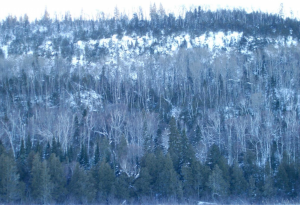
The ongoing legal battle over the South Fowl Snowmobile Trail was the subject of an October hearing. The Superior National Forest approved a plan in 2006 to relocate the trail from an illegal route through the wilderness, but environmental groups challenged the new route, saying it would still affect the Boundary Waters with noise pollution.
The continued challenge comes from environmental groups who say they didn’t get an appropriate chance to review and comment on the final plan, according to the Cook County News Herald. Dennis Nietzke, who was then the Gunflint Ranger, decided to construct the trail on a route closer to the BWCAW than environmentalists wanted, but said it would be shut down and another route constructed if it was abused. Environmental groups says they didn’t get a say in what would constitute abuse warranting relocation.
Attorney David Fuller of the U.S. Justice Department, representing the Forest Service, responded that a monitoring plan was included in both the draft and final plan, and it is clear what would lead to it being closed to use. He also claimed that there is little wilderness use in the area in the winter, and that snowmobiles can already be heard — at louder volumes than from the South Fowl re-route – from legal use on other nearby lakes.
In 2009, the Cook County board wrote a letter claiming the fight against the trail sought to create a buffer zone, which it opposed, “We feel it necessary to state that no action should ever be taken to create either legally or by custom a buffer zone of any kind near the boundaries of the Wilderness. Along with the deleterious economic and cultural effects, it should be noted that such zones stand in direct conflict to the intent of the BWCA Act of 1978.”
Kristen Marttila, the lawyer for the Izaak Walton League, Wilderness Watch, and Northeastern Minnesotans for Wilderness, told the judge that her clients don’t want a “buffer zone” around the wilderness. But she said certain uses are okay at the edge of the wilderness, and a snowmobile trail is not one of them.
The popular snowmobile trail has been used by people to access South Fowl Lake — popular for ice fishing — since the 1950s. When the 1978 Boundary Waters Canoe Area Wilderness was passed, it inadvertently included the trail in the new wilderness boundaries. That fact when unnoticed by anyone until 2003, when the Forest Service then closed it and began working on the re-route.
Judge John Tunheim said he would take the issue under advisement and issue a ruling as soon as possible.

